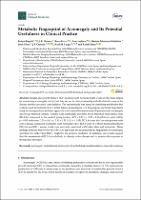Metabolic fingerprint of acromegaly and its potential usefulness in clinical practice
Author
Date
2019-09-26Permanent link
https://hdl.handle.net/11351/5111DOI
10.3390/jcm8101549
ISSN
2077-0383
WOS
000498398500047
PMID
31561638
Abstract
Insulin-like growth factor-1 (IGF-1) and growth hormone (GH) levels are the main targets for monitoring acromegaly activity, but they are not in close relationship with the clinical course of the disease and the associated comorbidities. The present study was aimed at identifying metabolites that could be used as biomarkers for a better disease phenotyping. For this purpose, metabolic fingerprint using an untargeted metabolomic approach was examined in serum from 30 patients with acromegaly and 30 age-matched controls. Patients with acromegaly presented fewer branched-chain amino acids (BCAAs) compared to the control group (valine: 4.75 ± 0.87 vs. 5.20 ± 1.06 arbitrary units (AUs), p < 0.05; isoleucine: 2.54 ± 0.41 vs. 2.80 ± 0.51 AUs; p < 0.05). BCAAs were also lower in patients with active disease compared to patients with normal levels of IGF-1 with or without medical treatment. GH, but not IGF-1, serum levels were inversely correlated with both valine and isoleucine. These findings indicate that low levels of BCAAs represent the main metabolic fingerprint of acromegaly and that GH, rather than IGF-1, might be the primary mediator. In addition, our results suggest that the assessment of BCAAs could help to identify active disease and to monitor the response to therapeutic strategies.
Keywords
Acromegaly; Metabolomics; Amino acidsBibliographic citation
Biagetti B, Herance J.R., Ferrer R, Aulinas A, Palomino-Schätzlein M, Mesa J, et al. Metabolic fingerprint of acromegaly and its potential usefulness in clinical practice. J Clin Med. 2019 Sep 26;8(10):1549.
Audience
Professionals
This item appears in following collections
- HVH - Articles científics [4476]
- VHIR - Articles científics [1751]
The following license files are associated with this item:

 Private area
Private area Contact Us
Contact Us








